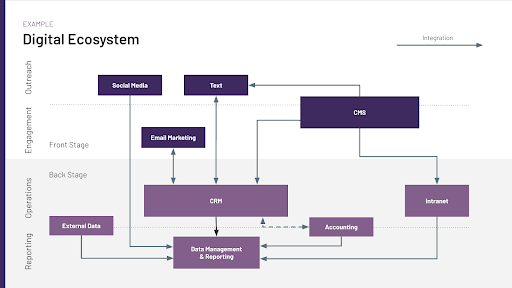Blog • Insights
Integrating CRM, Web Analytics, and Fundraising Data for a 360-Degree View
Picture this: A donor reads your email newsletter. A few days later, they signed up to attend a virtual event you promoted on social media. Inspired, they finally navigate to your site and make a $500 donation. To your organization, this represents one engaged supporter on a successful journey.
But to your systems, they look like three completely different people.
Your web analytics show an anonymous visitor. Your event platform records an attendee with no donation history. Your fundraising system captures a first-time donor with no context about their prior engagement. This fragmented view isn’t just a data problem — it’s preventing you from understanding your supporters, optimizing their experience, and ultimately maximizing your mission impact.
The solution lies in unifying your data sources. Doing so allows you to create a comprehensive 360-degree view of your organization’s digital performance. Beyond just improving internal decision-making and paving the way for smoother donor experiences, this unified approach is essential preparation for the AI-driven tools that will revolutionize nonprofit engagement.
The “Binoculars Problem”: Why Nonprofit Data is Siloed
Most nonprofit organizations today operate with multiple data systems that each serve important but distinct purposes. They use Google Analytics to track website behavior, CRM platforms like Salesforce to manage donor relationships, email marketing tools to nurture supporters, and specialized platforms for events, fundraising campaigns, and program delivery.
But when these systems operate in isolation, they create what we might call the “binoculars problem.” When you examine web analytics alone, you get a highly focused but limited view of user behavior during individual sessions. When you look at just your CRM data, you see the broad, long-term relationship but miss the nuanced digital journey that led to engagement. And so on.
This disconnect is becoming even more pronounced as increasing privacy regulations make it more difficult to track visitors across sessions and devices. That email subscriber who becomes a repeat website visitor often appears as “direct traffic” in your analytics, obscuring the true effectiveness of your email campaigns. Meanwhile, your CRM knows this person’s long-term engagement history but has no insight into their digital behavior patterns.
The cost of this fragmentation extends far beyond reporting confusion. When organizations can’t connect a supporter’s digital journey with their offline engagement and giving history, they miss critical opportunities to personalize experiences, optimize touchpoints, and identify the most effective paths to conversion.
The Benefits of 360-Degree Vision
Data unification isn’t just about better reporting — it’s about building the foundation for more effective, more personal, and ultimately more successful supporter relationships.
From your supporter’s perspective, your organization is a single entity. Whether they’re reading your email newsletter, scrolling past a post on social media, browsing your website, attending an event, or making a donation, they expect continuity and recognition. But when your systems operate in isolation, you deliver fragmented experiences that can feel impersonal and disconnected.
For instance, we know that timely thank-you communications and regular engagement updates are among the strongest predictors of repeat giving. If your donation platform doesn’t trigger appropriate follow-up communications through your email system, you’re missing fundamental opportunities to build lasting relationships.
This integrated approach is even more critical today, as artificial intelligence transforms how organizations engage with supporters. AI-powered personalization and recommendation systems depend on comprehensive data to deliver meaningful experiences. If an AI chatbot on your website doesn’t know that a visitor is a long-time member who recently attended three events, it can’t provide the personalized, contextual interactions that build deeper relationships.
Common Integration Challenges (And How to Solve Them)
The path to data unification involves real challenges, but understanding them helps frame realistic solutions and expectations.
Competing Ecosystems
Most nonprofits operate with piecemeal technology stacks that weren’t specifically designed to work together. Unlike for-profit companies that might choose comprehensive platforms like HubSpot or Adobe’s marketing cloud, nonprofits often select individual solutions based on cost, functionality, or even grant requirements. Each tool serves its purpose well, but they come from different vendors that have little incentive to facilitate data sharing. This creates a complex puzzle of integration points that requires custom solutions.
The solution lies in identifying which systems need to communicate most urgently and investing in targeted integration tools or middleware platforms that can bridge the gaps.
Resource Constraints
Custom integrations come at a higher cost and require a deeper bench of technical expertise, including everything from specialized development work and ongoing maintenance to technical staff who understand multiple platforms. It’s more than many nonprofits can easily afford, both in terms of upfront costs and ongoing resources.
Organizations can address this by setting realistic expectations about integration effort and costs when selecting tools and considering phased approaches that spread investments over multiple budget cycles.
Staff Turnover
The specialized skills required for data integration — like Salesforce administration and analytics interpretation — are in high demand in the for-profit sector. In such a competitive landscape, nonprofits frequently struggle to hire and retain staff with these capabilities, leading to knowledge loss and system fragility when specialized staff leave.
The key is to create thorough documentation of all integrations and consider hybrid approaches that combine internal advocacy with external expertise for implementation and maintenance.
Your Starting Point: Document and Prioritize
Fully unifying your data is likely to be a multi-year endeavor, so you’ll need to take a phased approach. Your first step is to take stock of your current data landscape and identify high-value integration opportunities.
Step 1: Document Your Systems
Create a visual map of all your data systems and their current connections. Most organizations operate anywhere from 4 to 12 different platforms, from major systems like CRM and analytics tools to specialized platforms for events, social media, and project management. As you map your systems, be sure to document:
- Which systems currently share data
- In what direction that data flows
- What your primary “source of truth” should be for any given data point or metric

Step 2: Identify High-Value Connections
Rather than trying to connect everything all at once, focus on integrations that would meaningfully improve your ability to serve your mission. For a museum, connecting ticketing data with membership information might reveal patterns about visit frequency and renewal likelihood. For an advocacy organization, linking email engagement data with website behavior could optimize campaign timing and content strategy. The integrations you prioritize should flow from your big-picture goals and rank highly in terms of operational or impact-related ROI.
Step 3: Start with Low-Hanging Fruit
Rather than waiting until you can afford comprehensive custom integrations, begin with simple connections that deliver immediate value. It’s possible to capture a number of benefits through relatively simple implementations. For instance, adding UTM parameters to email campaigns instantly reveals how much of your web traffic comes from existing contacts. For organizations using Mailchimp, adding UTM parameters can be accomplished in a few clicks by enabling their Google Analytics 4 integration.
4 Essential Tips for Long-Term Success
In the long run, unifying your data depends not just on choosing the right connections to make, but on building sustainable practices that can withstand staff changes, budget fluctuations, and evolving organizational needs.
1. Set Realistic Expectations
Data unification isn’t a one-and-done project. It’s an ongoing part of your digital strategy that will inevitably evolve with your organization’s needs and the technology landscape. Setting realistic expectations about the longterm nature of the project helps ensure sustainable success.
2. Embrace a Longer Timeline
Most comprehensive integration projects unfold over multiple years, with organizations prioritizing different connections based on changing needs and system upgrades. This extended timeline isn’t a limitation — it’s a feature that allows for learning, adaptation, and avoiding the disruption of trying to change everything simultaneously.
3. Prioritize Documentation
When integration systems are custom-built, organizational knowledge about how they work and how to maintain them must be captured and shared. Documentation is critical, particularly given staff turnover challenges.
4. Prepare for the AI-Driven Future
Perhaps most importantly, beginning this work now positions your organization for the AI-driven future of supporter engagement. As artificial intelligence becomes more sophisticated and accessible, the organizations with unified, comprehensive data will be able to leverage these tools most effectively.
Organizations that invest in understanding and connecting their data sources now will find themselves increasingly advantaged in competitive funding environments, better equipped to serve their missions, and prepared to take advantage of the transformative technologies that lie ahead.
Ready to start mapping your data landscape and identifying integration opportunities? Forum One can help you develop a strategic roadmap that aligns with your mission priorities and organizational capacity.
